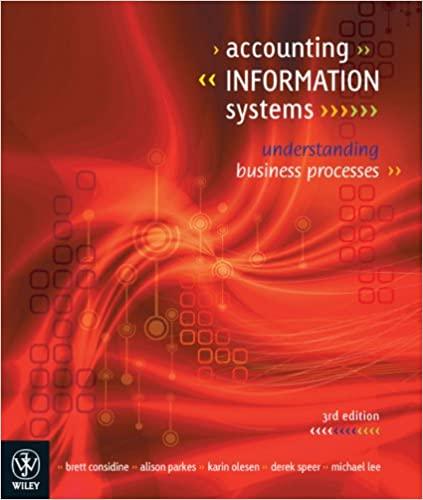Strides for Strides manufactures and sells athletic wear to retail stores, who then stock the goods and
Question:
Strides for Strides manufactures and sells athletic wear to retail stores, who then
stock the goods and sell them to customers. Its range of products includes warm-up
tracksuits, body suits and running shoes and spikes. The business process followed
by Strides for Strides in supplying retail stores is as follows:
® The retail store will send an order to Strides for Strides, where it will be received
by the customer service representative. Orders are generated by and originate
from the retail stores and can arrive on an ad hoc and irregular basis. Retail
stores, while all being long-standing and regular customers, have typically
ordered at the last minute, resulting in irregular demand levels across the year.
Two copies of the order form are made, with one being sent to the warehouse
assistant, who checks that all goods are available for dispatch to the retail store.
The second copy goes to the accounts receivable office.
® Once confirmed as available, the goods are packed, manually recorded on the
goods release form (two copies are prepared) and sent to the shipping department
for dispatch. A courier collects goods and a goods release form every morning
and afternoon and delivers these to the retail store. Once delivery details are
confirmed, an invoice is prepared by accounts payable, based on the details in
the customer order and the goods release form. Paper invoices are sent out at the
end of each week. Retail stores currently have standard payment terms of 2/15,
n/35. Payment is made in the form of a cheque, which is sent back to the customer
service representative who forwards it on to the accounts receivable office.
Strides for Strides has recently noticed that it is having inventory management
problems due to the spasmodic and irregular nature of orders. This has impacted
on its own ability to meet customer demands. It is also concerned that incorrect
quantities of goods may be packed and shipped, and not detected until the goods
reach the retail stores. This introduces extra costs of handling returns and allowances.
Strides for Strides has also noticed that its accounts receivable turnover has
dropped from 11.7 times per year to 9.5 times per year over the last 12 months.
An independent consultant has suggested that by re-engineering the process
these problems could be addressed.
Required
(a) For the business process described above, identify:
(i) the participants.
(ii) the inputs.
(iii) the outputs.
(b) Identify and describe any inefficiencies that are present in the current system.
(c) Suggest ways that the business process inefficiencies could be corrected
through business process re-engineering.
(d) Prepare a brief narrative that describes how your newly re-engineered system
would operate.
(e) Identify and describe the role that technology would play in implementing your
proposed changes.
(f) Describe some of the issues that may be faced by Strides for Strides in
re-engineering processes. Propose some strategies for dealing with these issues.
Describe the differences between RFID and barcodes as a means of capturing data
in a process. In what situations may RFID be preferable to barcodes?
Step by Step Answer:

Accounting Information Systems Understanding Business Processes
ISBN: 9781742165554
3rd Edition
Authors: Brett Considine, Alison Parkes, Karin Olesen, Michael Lee, Derek Speer





